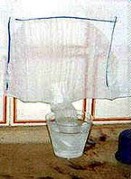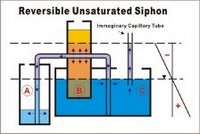 Porosity can be designed to have pores connected continuously.
Porosity can be designed to have pores connected continuously.
Wicks cannot be made of nylon cords because they fail on oil lamps allowing a more appropriate conception.Connected pores of an advanced porosity offers deep reliability to Unsaturated Hydraulic Flow because of Molecular Connectivity, reduction of dead ends and stagnant regions common on random porosity.
- Connected pores offers anisotropy important to move fluid around taking advantage of a prevailing direction.
- Experts working with wicks like Mechanical, Chemical, and Textile Engineers or Chemists were not aware of many insights available at disciplines like Plant and Animal Physiology, Soil Physics, and Hydrogeology.
The Epistemological and Metaphysics Underlying Approach of Tubarc/Masstubarc is Geometrical and not Numerical. Consequently, it can accept a broad range of possible quantification rules.
Introducing Tubarc and Masstubarc
 The conceptions are a sort of 'scientific discovery' in dynamics associated to molecular connectivity on mass flow. The basic applications would be:
The conceptions are a sort of 'scientific discovery' in dynamics associated to molecular connectivity on mass flow. The basic applications would be:- Porosity Geometry
- Fluid Retention/Delivery
- Energy Exchange between inertial and rotating forces by non partitioning of Mass Movement.
Tubarc is an issued patent US 6,766,817 July, 27 2004 ‘Fluid conduction utilizing a reversible unsaturated siphon with tubarc porosity action’. Masstubarc is a pending patent filed in-continuation to Tubarc patent.
Molecular connectivity is the backbone of Tubarc and Masstubarc.
Molecules are attached to each other in the process of mass flow and the best way to assess such functioning is by employing simple experiments gauging parameters of unsaturated hydraulic flow developed by Tubarc Porosity. It happens when fluids are moving under its own adhesion-cohesion properties attracted to a special solid porosity surface which provides an interface for stressing the connectivity of the molecular bounding.
On the right picture this simple display would portray the strength and importance of molecular connectivity on general mass conduction processes. Molecular connectivity has been ignored in Fluid Mechanic principles when cutting/splitting devices like impellers, propellers, vanes, runners, valves, pistons, etc. are employed on mass flow operations.
The evaluation procedure can be quite simple requiring just a small piece of drying paper hanging on the wall connected to a water deposit like the figure on the right. Slowly water moves upward in all directions depicting clearly the spatial dynamic modeling of unsaturated hydraulic flow on a porosity media of an unorganized random system as a drying paper for spatial assessment of hydrological parameters.
Tubarc - It was derived from deep insights of Plant Physiology combined to Hydrogeology, Soil Physics, and recent plastic technology advancement of fiber production industry.
Masstubarc - It was created from a necessity to increase speed of natural unsaturated hydraulic flow through the Enhanced Tubarc Porosity. It led to new conceptions of energy exchange on mass flow and brought deep insights to dynamic principles with preservation of molecular connectivity by geometrical contention during the process of adding/removing energy to a moving mass.
Background – Tubarc (Tube+Arc) is centered around Plant Physiology
 The figure on the left provides some hints that around 400-600 millions of years ago unicellular organisms started packing themselves together, and/or dividing into multicellular growing larger organisms. Water needed to be continuously distributed inside the growing being and specific conducting cylindrical structures like xylem and phloem were spontaneously developed to provide faster bulk delivery of fluids internally.
The figure on the left provides some hints that around 400-600 millions of years ago unicellular organisms started packing themselves together, and/or dividing into multicellular growing larger organisms. Water needed to be continuously distributed inside the growing being and specific conducting cylindrical structures like xylem and phloem were spontaneously developed to provide faster bulk delivery of fluids internally.
Cylinders are special geometrical containment to transfer masses between two places, but are not appropriate to deliver to a biological porosity with multiple continuous input/output throughout the cylindrical walls. Then, it developed special perforations slitting the lateral walls to let fluids in or out whenever needed. Tubarc was based on such structure functioning to solve misconceptional problems of unsaturated hydraulic flow of capillary action. Furthermore, rocks and soils are just random porosities having no specially organized arrangement of pores, leading to dead ends, stagnant, and clogged regions impairing deeply flow connectivity.
Tubarc conceptions offer a very special enhanced porosity having a continuous cylinder with a lateral slit allowing a high level of anisotropy, prevailing directional flow, and near 50% of void in the total volume.









